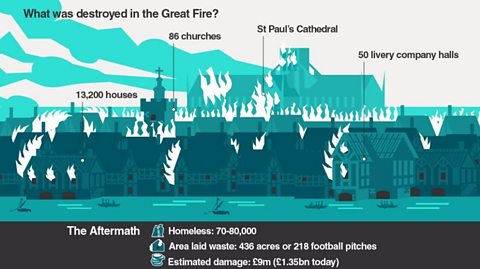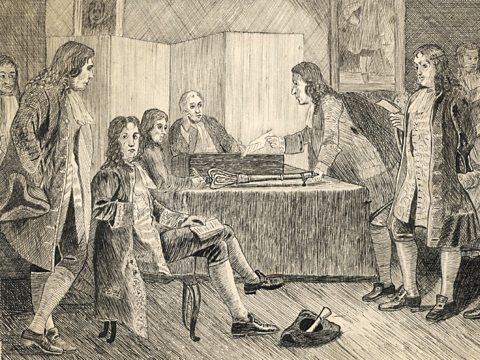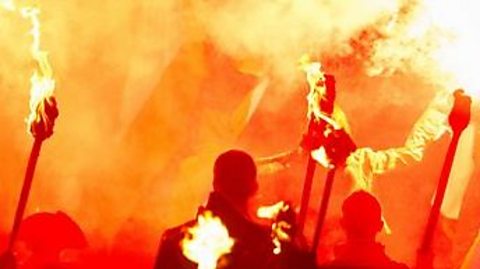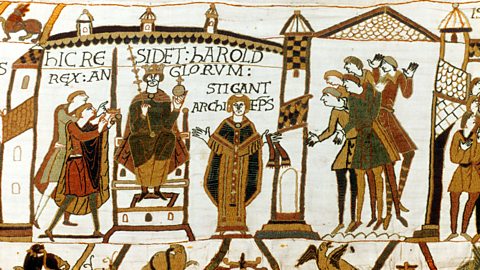London's burning
When the Great Fire of London broke out in 1666, it was so large the smoke could be seen in Oxford. It raged for four days, destroying 80 per cent of the city. Diarist Samuel Pepys wrote that “with one's face in the wind, you were almost burned with a shower of firedrops.”
But as London’s medieval heart lay smouldering, some saw a golden opportunity to break with the past and create a modern, magnificent city. They began making plans for a revolutionary new London.
The fire in figures
The great fire started in Pudding Lane on 2 September and spread rapidly westwards towards Fleet Street. It almost reached the Tower of London in the east.


A new vision for the city
The fire broke out during a time of great upheaval in Britain, with old certainties shaken by the English Civil War.
A new intellectual elite was emerging, made up of men keen to share ideas and scientific discoveries. They believed London’s medieval structure with timber fronted buildings, network of alleyways and open sewers no longer reflected the ideals of the age. The fire provided a rare chance to create a modern capital.
Steeped in mathematical knowledge and the writings of the ancients, like Roman architect Vitruvius, they imagined a spacious, well planned city to rival the splendour of ancient Rome.
Men of science
With the embers still burning, London's intellectuals finalised their plans for the city. The most famous of these came from Royal Society members John Evelyn, Christopher Wren and Robert Hooke.
Hooke designed a regimented grid-iron plan, inspired by the cities of the ancient world, while Evelyn and Wren imagined a city of piazzas, with St Paul’s Cathedral and the Royal Exchange at its heart.

WATCH: London's lost city
Sadly for the men who dreamt of progress, Wren's brave new city was rejected. Citizens didn't want to surrender their plots of land to his vision and refugees from the fire, camping out at Moorfields, were facing starvation. The King decided to restore London along its original medieval plan but gave his architects the opportunity to embark on some innovative architectural ventures.
The plan favoured by the King belonged to Christopher Wren.
Watch the clip below to see what it would have looked like.
Wren’s vision for London
'London was but is no more.' Over 13,000 buildings were destroyed. It was the calamity of the age, but the smouldering hole at the heart of the city would prove to be a huge inspiration. Plans were drawn up to bring a new order of beauty to London.
Architect Christopher Wren proposed a London to rival the glories of ancient Rome - triumphal avenues and great piazzas.
At its heart - the new Cathedral of St Paul's.
Wren would create the first dome to be seen in London. It would be a new age of classicism, of harmony and proportion, banishing forever the chaos of the old Gothic city. St Paul's would be the symbol of a London reborn, a great phoenix risen from the flames.
Had Wren’s plans for the whole city been realised, the look of London would be very different.
CLICKABLE: Can you see Wren's vision today?
The map below shows the area of London affected by the great fire.
Click or tap on the hand to discover how the city changed and which iconic buildings arose from the ashes.
Learn more about this topic:
Guy Fawkes: Why do bonfires still burn 400 years on? document
An interactive article looking at why we light Guy Fawkes effigies on bonfires on November 5th. Plus how Gunpowder Treason Day became fireworks night over 400 years.

How did slave owners shape Britain? document
Discover who Britain's forgotten slave owners were and how their actions still impact our lives today.

Why should I care about 1066? document
The legacy of this brutal conquest - the last time England was successfully invaded – pervades many aspects of our language and culture today.
